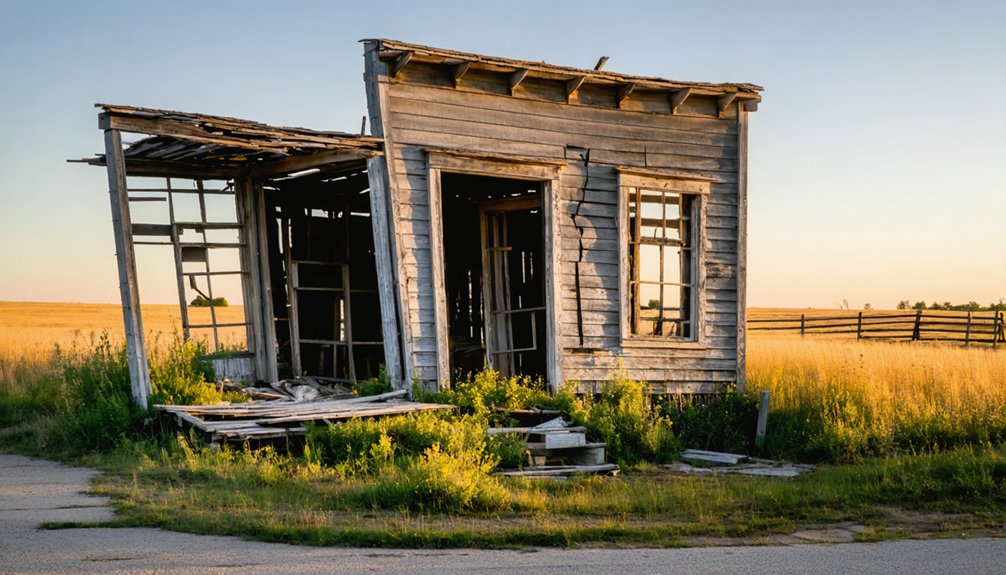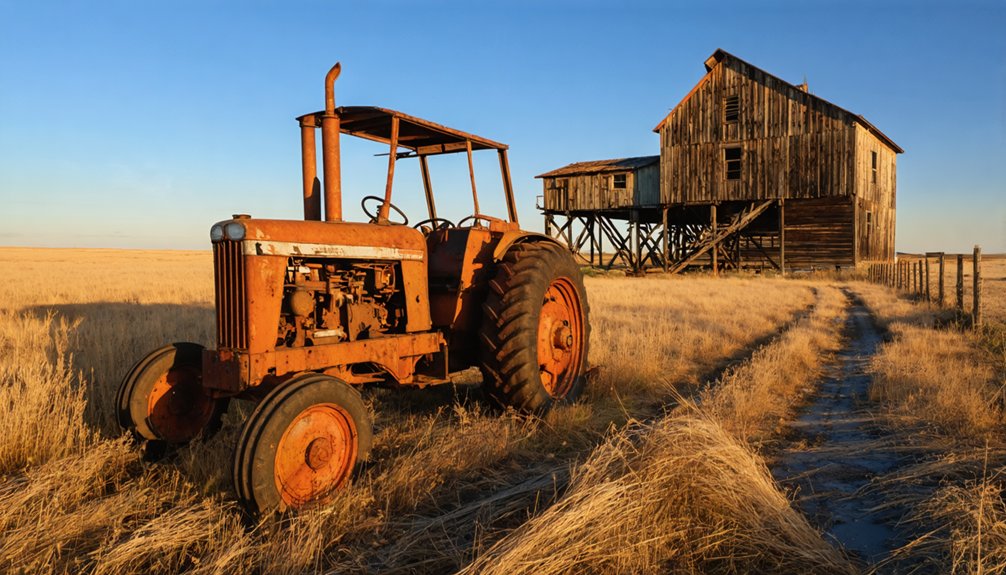You’ll find Hooker’s remains at 43°12′00″N 97°01′29″W in Turner County, South Dakota. Founded in 1894 along the Chicago & North Western Railway, this frontier settlement thrived as an agricultural hub with bustling stockyards and essential services. A devastating 1903 tornado destroyed most businesses, including the railroad depot, marking the town’s decline. The post office closed in 1954, and today only a commemorative steel sign and scattered artifacts in local museums tell Hooker’s frontier story.
Key Takeaways
- Hooker was founded in 1894 along the Chicago & North Western Railway as a frontier settlement in Turner County, South Dakota.
- A devastating tornado in 1903 destroyed most of Hooker’s commercial district, marking the beginning of the town’s decline.
- The town served as an agricultural hub with stockyards and grain elevators until its post office closed in 1954.
- Today, Hooker exists only as an empty plot marked by a commemorative steel sign at coordinates 43°12′00″N 97°01′29″W.
- Historical artifacts from Hooker, including original post office boxes, are preserved in the nearby Viborg museum.
The Birth of a Railroad Town
When the railroad companies expanded their networks across South Dakota in the late 19th century, the small town of Hooker emerged along the tracks in Turner County.
You’ll find its origins tied to the railroad development that transformed the Dakota Territory, as pioneer settlers sought new opportunities in 1894. The town’s namesake, John Hooker, was among these early settlers who recognized the potential of establishing a community along the rail line.
Like many railroad towns of its era, Hooker became a crucial hub for the surrounding agricultural community. The rail connection provided essential services, from mail delivery to grain shipments, while the depot served as a gathering place for locals and newcomers alike. A key part of the town’s infrastructure included the post office until 1954.
The railroad’s presence promised economic growth and connected Hooker’s residents to broader markets across the region.
Early Days Along the Chicago and North Western Line
The Chicago & North Western Railway‘s arrival marked a defining chapter in Hooker’s story. As part of the railroad’s massive expansion across South Dakota, you’d have found Hooker situated along a crucial branch line connecting Iroquois to Beresford.
By 1890, the C&NW had laid over 800 miles of track throughout the state, transforming isolated prairies into connected communities. Due to the various historical references associated with the name, regional context became crucial in distinguishing this location from others. The railway system generated impressive annual earnings of $100,000,000 through its extensive operations.
You could’ve witnessed the economic development firsthand as stockyards sprung up near the tracks, connecting local ranchers directly to lucrative markets in Sioux City and Chicago. The railroad didn’t just move cattle and crops – it brought mail, supplies, and new settlers to town.
The railroad transformed prairie outposts into bustling hubs, bringing prosperity through new markets, vital supplies and waves of settlers.
For early residents, the railway depot became their lifeline to the outside world, a symbol of progress that helped their remote prairie town thrive.
Life in a Thriving Prairie Community
During its peak years, Hooker buzzed with the hallmarks of a vibrant prairie community.
You’d find farmers hauling grain to the elevator while livestock awaited shipment at the bustling stockyard. The railroad connected you to major markets in Sioux City and Chicago, while also providing transportation to events like the State Fair. The cattle transport by trucks eventually replaced the need for rail shipping.
Daily life centered around essential services – you could stop by the general store for supplies, visit the barber for a trim, or drop off cream at the dairy station.
The school served as a hub for community gatherings, where neighbors would meet and socialize. Agricultural practices dominated the local economy, with the surrounding prairie supporting both crop and livestock operations.
Even after a devastating 1903 tornado, the town’s spirit and determination helped rebuild its downtown core.
Natural Disaster and Its Impact
Hooker’s path toward becoming a ghost town began with a devastating tornado in 1903 that ripped through its commercial district. The tornado devastation left most businesses in ruins, including the crucial railroad depot that connected the town to major trade routes in Sioux City and Chicago. Like other ghost town sites, buildings fell into varying states of disrepair and abandonment.
A single tornado in 1903 devastated Hooker’s business district, destroying its vital railroad depot and sealing the town’s fate.
You’ll find that this natural disaster marked the beginning of Hooker’s decline, as reconstruction efforts proved minimal. Today, visitors should exercise respect for private property while exploring the remnants of this once-thriving town.
The economic repercussions were far-reaching. The town’s role as a livestock shipping point diminished considerably, and businesses struggled to recover. Without a functioning depot, the town’s commercial activities dwindled.
As essential services disappeared and employment opportunities vanished, residents gradually moved away. By 1954, even the post office closed, leaving Hooker to fade into the quiet prairie landscape.
The Railway’s Departure and Town’s Decline
While many factors contributed to Hooker’s downfall, rail transportation’s decline dealt the most severe blow to this once-thriving South Dakota community.
You can trace the town’s deterioration alongside the railway abandonment consequences that swept through the region post-1950s. This mirrored the statewide trend where over 60% of railroads disappeared by 1980. As rail companies discontinued their less profitable rural lines, Hooker’s lifeline to larger markets began to fade.
The closure of the post office in 1954 marked a turning point, reflecting the broader rural depopulation trends affecting similar towns across South Dakota. The depot, once a bustling hub of social and economic activity, fell silent.
Without rail access, local farmers couldn’t efficiently transport their goods, and businesses struggled to survive. By the 1980s, Hooker had joined the growing list of South Dakota ghost towns.
Preserving Hooker’s Heritage
You’ll find original post office boxes from Hooker proudly displayed at the Viborg museum, preserving a tangible piece of this pioneer settlement’s history.
Like many ghost town relics, abandoned buildings and artifacts chronicle the story of life in this once-thriving community.
Local community members share photographs and stories on social media platforms, keeping the town’s memory alive through digital documentation.
These preservation efforts, though modest, help maintain awareness of Hooker’s significance in Turner County’s development since its 1894 founding.
Museum Artifacts Today
Today, several museums across Turner County and surrounding areas preserve the heritage of Hooker through carefully curated artifacts.
You’ll find the most extensive collection at the Viborg Museum, where original post office boxes and postal service documents showcase the town’s communication hub before its 1954 closure.
Local exhibitions feature agricultural implements from Hooker’s prosperous days as a livestock shipping point on the Chicago and North Western railroad.
The artifact conservation efforts include schoolhouse memorabilia, railroad depot items, and remnants from local businesses like the general store and cream station.
These collections help researchers and descendants trace their roots while documenting the impact of the 1903 tornado that contributed to the town’s decline.
Like many frontier towns of the era, Hooker struggled with maintaining law and order in its early days before establishing proper governance.
You can explore these pieces of history through combined displays of physical artifacts and oral histories similar to the way Mount Moriah Cemetery preserves Deadwood’s historical legacy.
Community Memory Projects
Despite Hooker’s physical absence from modern maps, community-driven memory projects keep the town’s heritage alive through diverse platforms.
You’ll find digital storytelling thriving on the “You know you’re from Hooker, SD if…” Facebook page, where residents share vintage photographs and memories of vanished landmarks. The steel town sign near Viborg, crafted by Lynn’s Welding, stands as a visual representation to lost structures like the church, school, and railroad depot.
Community engagement extends to the preservation of oral histories, documenting pivotal events like the 1903 tornado and daily life in this former livestock shipping hub.
The nearby Hattervig Cemetery serves as a tangible link to the past, while social media discussions enable descendants to connect and share stories, ensuring Hooker’s legacy endures through both physical and digital preservation efforts.
What Remains Today

While most ghost towns retain at least a few original structures, Hooker, South Dakota stands as little more than an empty plot marked by a commemorative steel sign.
You’ll find no original buildings, no bustling railroad depot, and no historic Main Street to explore. The steel marker, crafted by Lynn’s Welding in Viborg, depicts the ghost town’s former glory – showcasing the church, elevator, school, store, and depot that once defined this rural community.
Today, you can spot the site using its coordinates (43°12′00″N 97°01′29″W), though you won’t find much beyond open land.
The town’s historical significance lives on primarily through preserved post office boxes in Viborg’s museum and old photographs in regional archives.
The nearby Hattervig Cemetery offers the only tangible connection to Hooker’s former residents.
Legacy of a Lost Settlement
Founded in 1894, Hooker, South Dakota emerged as a promising frontier settlement named after pioneer John Hooker, quickly establishing itself as an essential hub for regional agriculture and commerce.
Today, you’ll find little evidence of this once-thriving community, but its cultural significance endures through local historical accounts and folklore. The town’s story mirrors the economic shifts that reshaped America’s rural landscape throughout the 20th century.
Ghost towns like Hooker remind us how economic change can erase physical traces while leaving deep cultural imprints in community memory.
After surviving a devastating 1903 tornado, Hooker’s ultimate decline began with the 1954 post office closure and the railroad’s withdrawal. What was once a bustling stop with stockyards, stores, and a school now stands as a poignant reminder of how transportation networks and changing agricultural patterns can determine a settlement’s fate.
Hooker’s legacy lives on as a symbol of the American frontier’s impermanence.
Frequently Asked Questions
Were There Any Notable Crimes or Criminal Activities in Hooker’s History?
You won’t find documented historic crimes or unsolved mysteries specifically tied to this location – unlike nearby Deadwood’s well-known criminal past, records don’t reveal any notable criminal activities here.
What Happened to the Original Residents’ Descendants After Leaving Hooker?
You’ll find most descendants scattered across South Dakota and neighboring states, though tracking their family legacies proves challenging due to limited records. Many likely settled in nearby towns like Viborg.
Did Any Famous People Ever Visit or Live in Hooker?
You won’t find any famous visitors or residents in this town’s records. Despite serving 60+ years as a railroad stop, only John Hooker, the pioneer settler, holds any historical significance here.
Are There Any Paranormal Stories Associated With the Abandoned Town?
You won’t find documented ghost sightings or paranormal investigations here. Local history focuses on the town’s decline after the 1903 tornado, with no verified supernatural claims in available records.
What Was the Highest Recorded Population of Hooker During Its Peak?
You won’t find exact peak population records for this historical railroad stop. Despite its significance in livestock shipping and population growth during the early 1900s, no credible documentation of maximum residents exists.
References
- https://b1027.com/south-dakota-ghost-towns-tour-hooker/
- https://www.youtube.com/watch?v=Glucs_Rq8Xs
- https://www.blackhillsbadlands.com/blog/post/old-west-legends-mines-ghost-towns-route-reimagined/
- https://core.ac.uk/download/pdf/345016075.pdf
- https://en.wikipedia.org/wiki/List_of_ghost_towns_in_South_Dakota
- https://b1027.com/take-a-quick-south-dakota-ghost-town-tour/
- https://kikn.com/have-you-ever-been-to-hooker-south-dakota/
- https://history.sd.gov/preservation/docs/SDRailroad.pdf
- https://www.sdhspress.com/journal/south-dakota-history-5-2/railroads-and-the-settlement-of-south-dakota-during-the-great-dakota-boom-1878-1887/vol-05-no-2-railroads-and-the-settlement-of-south-dakota-during-the-great-dakota-boom-1878-1887.pdf
- https://kids.kiddle.co/Hooker



